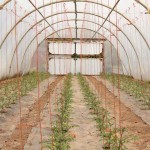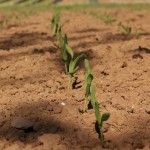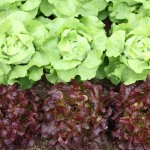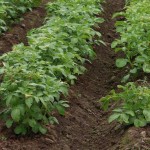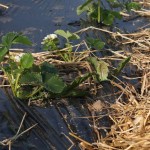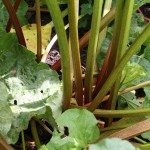Posted: July 8th, 2010 | Author: Halbe | Filed under: France, Wine | 7 Comments »
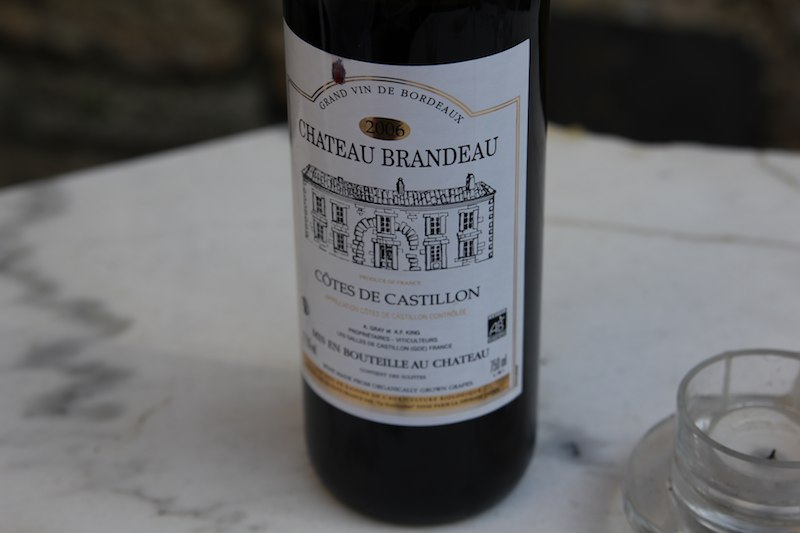
Disclaimer: I speak in generalities in this post. There are exceptions to every rule.
France and California are two of the major wine producers in the world (joined recently by Australia). However, there are some significant differences between the two industries and the wine they produce. We had the pleasure of enjoying a weekend in Bordeaux at their annual Fet la Vin (wine festival) and tasted some amazing wines. But we also learned quite a bit about how CA and French wine differ.
First, the overall feeling toward California wine in France is one of slight disgust. The vintner at our last winery described CA wine as, “fast, sexy and simple.” CA and France grow their grapes and make their wine very differently.
The French wine industry is bathed in tradition. They’ve been making it since the Roman times (read, over 1,000 years). They have a lot of respect for this tradition and it significantly restricts the way wine can be made and grown. The main regulatory body of wine in France is the AOC (L’appellation d’origine contrôlée). They require vines to be grown a certain distance apart. This spurs competition between the vines. They also don’t allow France to irrigate their vines. The reason for this is not only that the French believe the vines need to “suffer;” they also want their wine to reflect the weather of that year, to make it unique. If there’s a dry year their grapes will differ from a wet year.
In France, they always put the year of wine on the bottle, called the “vintage.” One year from the next can be drastically different. They additionally tend to mix grapes and many regions will grow the same grapes. So, if you have a bottle of red wine from Bordeaux there is a 99% chance they used merlot and cabernet franc. If you have a white wine from Bordeaux, they’ve used sauvignon blanc and semillon. Sometimes they list this on the bottle, but generally, they expect you to just “know” this.
As I’ve mentioned, the vintage is important to the vintner. They list the year which will likely tell a local if it’s a good bottle or not – 2005 was a dry year so the wine isn’t as good while 2006 was a year a lot of sun and just enough rain so it’s a better year, etc. Not easy if you’re not a local. So, in this vain, they do not mix their vintages. And if they do, they can’t put the year on the bottle, which is a hallmark of the French wine industry.
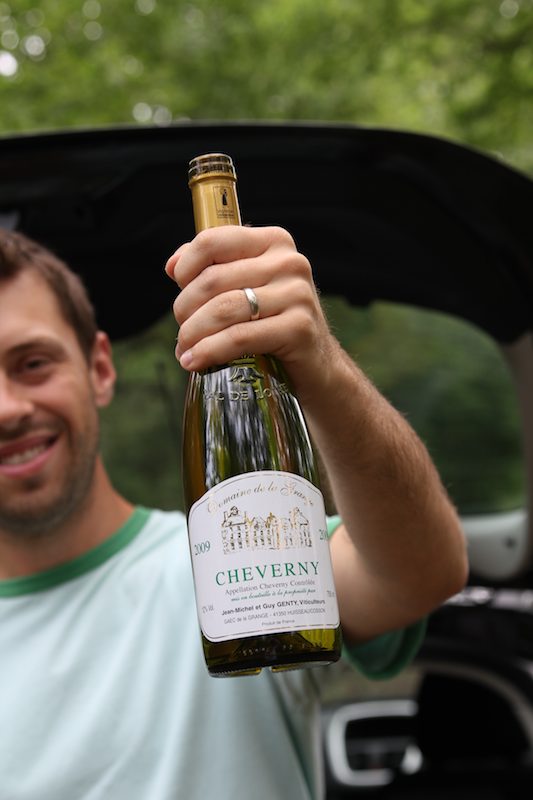
Lastly, the average winery in France is approximately 10 hectares (24.7 acres). The the most expensive wineries in France will even grow just 3-4 hectares to minimize the number of bottles they produce which affects their price. In Saint Emillon, the most expensive region of wines in France, they usually only produce 3 hectares of grapes and produce 10,000 bottles each year making their wine all the more in demand and harder to find. They sometimes go for over $1,000.
All this said, California does the opposite in most scenarios.
In California, their wineries are hundreds of acres. They also water their vines in addition to putting heaters around them, adding nitrogen to their soil and well, babying the heck out of them (pssst, some French wineries do this too). Their vines are essentially the same each year to make their wine consistent. Consistency is one of the major differences between French and Californian wines. The French snub their noses to this concept. Consistency? How is that interesting?” they say.
To make Californian wine consistent, the wineries will mix vintages. This difference is appalling to the French who look down on mixing years. But in California, to make their wine generally taste the same each year, they’ll, for example, mix a little of 2005 with 2009 to make sure it has that same clean, crisp chardonnay taste their customers count on.
They also tend to use a single grape variety like chardonnay or merlot. Now, there are of course exceptions, but when you buy a CA wine, it usually will say chardonnay or merlot on the label. That’s because they use just that grape, or the vast majority of the wine is made with that grape.
Although some CA wineries will label their vintage on the bottle, a bottle of 2005 chardonnay from one winery will taste almost exactly the same as the bottle of 2008 from the same winery. I was talking to one of the other Helpx’ers at the last winery, and when we were talking about this very subject she had a great example. She said she had been buying chardonnay from the same winery for years. It was consistently the same taste she’d counted on from a 2003 to a 2005 to a 2009. It didn’t matter the year, it was always the same wine. CA is known for this reliability to their customers and the French just don’t understand. In their mind, the different vintages should taste different.
The last difference I’m finding is one of personal taste. For those who know me fairly well, I don’t like red wine very much. At least, I used to not like it. I’m finding that the reds in Bordeaux are wonderful and I like them very much. They don’t have the bold strong flavor California reds are known for. The French call it “simple.” Whatever it is, it’s not my taste so when I go back to Cali, I’ll be buying my reds from the French.
I’m actually really excited to go wine tasting in California again with my new found knowledge of wine. It’ll make it more interesting. Oh, and it gives me another reason to drink a lot of wine!
Posted: July 7th, 2010 | Author: Halbe | Filed under: France | 6 Comments »
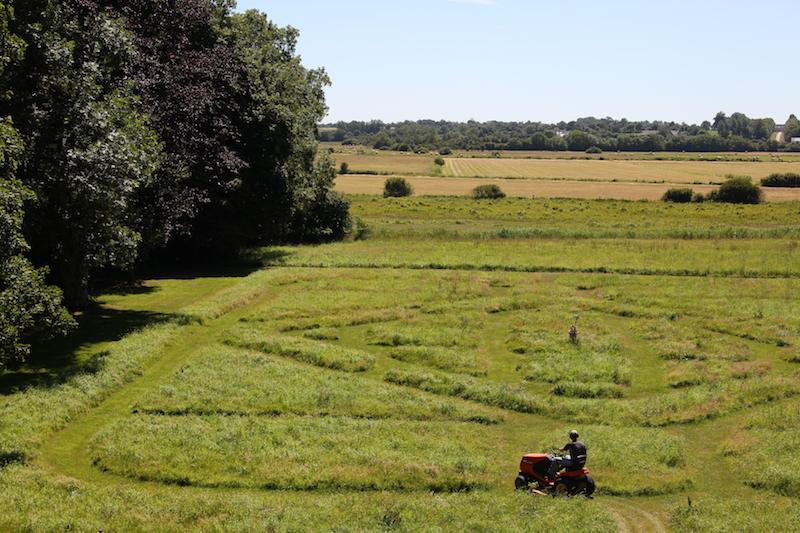
That is all.
Posted: June 16th, 2010 | Author: Halbe | Filed under: Uncategorized | 5 Comments »
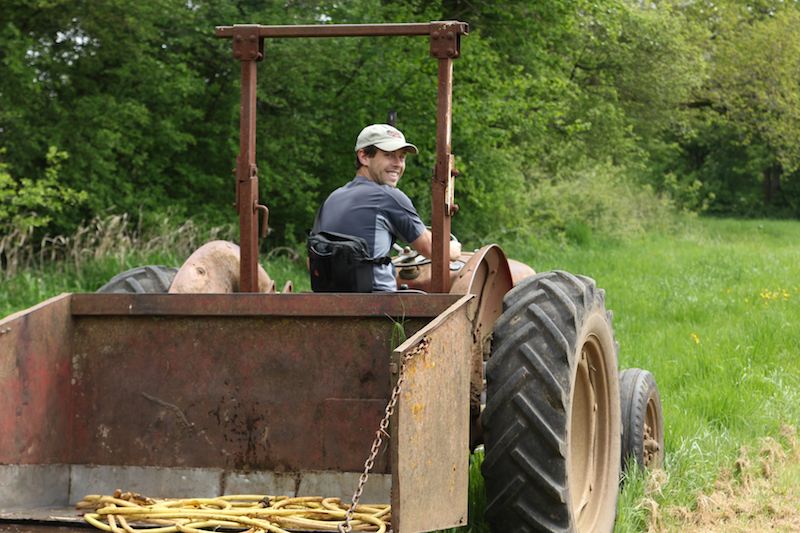
That is all.
Posted: June 13th, 2010 | Author: Halbe | Filed under: Growing Food, Wales | 13 Comments »
For the last month and a half Devon and I have been working on organic farms (certified and non-certified) in Europe. While here, we’ve actually learned quite a lot about the fresh produce we find on our plates for breakfast, lunch and dinner. What’s surprised us both is how little we know about the actual plants from which our produce grows.
Here are a number of pictures of produce growing from the vegetable and fruit farm we worked on in Wales. I could identify but a few without help when we first got there. Can you guess what’s what? I’ve put the answers in the comments section. How many did you get right?
In addition to learning what my veggies and fruit look like in the ground, I learned a few things about how the plants grow which surprised me. To a farmer, this is basic knowledge, but to a city girl, it was quite the revelation. The most surprising thing to me was that when we eat broccoli, we’re actually eating the immature flower. If farmers didn’t cut the broccoli head from the plant, it would blossom with little yellow flowers.
The second thing that surprised me was the potato plant. I hadn’t really thought about what a potato plant looked like just that the potato was a “root vegetable.” The potato is really a modified leaf. It isn’t a root at all! Potatoes grow underground inside ridged mounds. The higher the dirt covers the plant, the more potatoes it grows. If a potato breaks the surface it turns green, like a leaf, and becomes poisonous.
Lastly, when I was in Devon I learned about the bay leaf. Whenever I’m making soup, it usually calls for a bay leaf or two. But where does one get a bay leaf? Usually, we go to the herbs section of the grocery store and it’s conveniently in a little container for us. But, we have no idea it comes from a tree and what we use in our soup are the dried leaves.
There is tons more I can share, but I fear I’m inching into geek territory. The point though, is that we eat broccoli, bay leaves and other fruits and veggies every day. We don’t even consider what they look like in the ground. It’s all so conveniently located in the store or the farmers market that we don’t have to worry about it. I think though, that in order to truly appreciate what’s on your plate we need to understand where it comes from. And, well, now you know what eight more veggies and fruits look like when they’re growing on the farm. Don’t forget to click in the comments section to see how many of the veggies/fruit plants you got right!
Posted: May 20th, 2010 | Author: Halbe | Filed under: Schedule, Wales | 9 Comments »
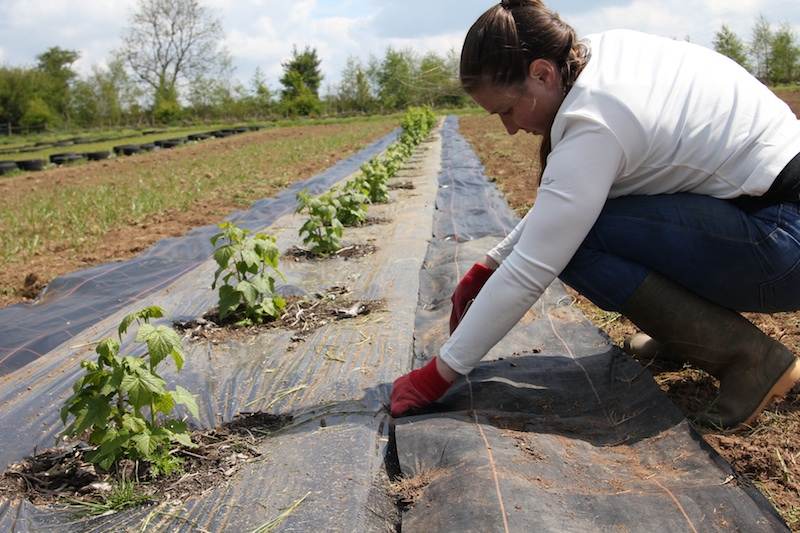
When Devon and I decided to learn about farming we knew it would be hard work. In fact, we were counting on it. And we got what we expected. Farming is, as the saying goes, “back-breaking” work.
Even though we try and avoid bending over too much, it inevitably happens. When we’re weeding we’re bent over, when we’re planting we’re bent over, when we’re shoveling, and hoeing…well, you get the idea. So, we unsurprisingly have sore backs and muscles, almost all the time. Since starting our journey we’ve done a lot of work in gardens and vegetable fields, which is where most of our back-breaking work takes place. Right now, we’re at a vegetable and fruit farm which does everything by hand instead of using chemicals, as it’s an organic farm. They use rather primitive machinery for some things, but all of their farm equipment was probably top of the line in 1950.
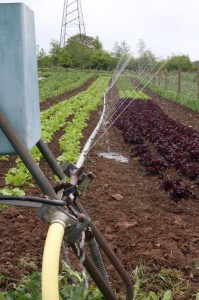
The difficult to move irrigation rig
Today is a good example of a typical day on the veg farm. First, we moved their irrigation system (read, very large sprinkler) from one veg bed to a neighboring veg bed. The irrigation system is comprised of 12 hollow metal poles, each about 13 feet long lined with little holes for the water to come spurting out. We walk 4 poles at a time with 2 people coordinating our steps so that we are moving at the same pace. This sounds like an easy task, and it is logistically. But, manually, carrying these poles 3 times across a football sized field can be tiring.
After we moved the irrigation system we went into one of their polytunnels (2,000 square feet of protected soil) and hand-weeded zucchinis. To do this, we’re squatting or on our knees picking out the weeds and placing them in a bucket. Then, after we were done with that (which took us about 40 minutes) we had to weed the walking paths between the zucchini. It sounds silly, but they also need to be free of weeds because eventually the zucchini grows so large it’s hard to get in there and weed. We get it all out while we still can. The walking path is much more packed earth, as we walk on it, and therefore harder to pull the weeds out. So, we use a hand fork or trowel — crouching, bending and kneeling all the while.
When we were done with that, it was tea time so we went inside for some toast and tea. A 20 minute break is welcome at this point as we’re tired of being on our hands and knees. But, we’re right back on them when tea is over because then we planted about 600 brussel sprout plants. The way we did this today was one person takes the plant out of the tray and tosses it onto the earth where the sprout will be planted. Then, following that person is a “planter” on each side of the bed (there are two rows) planting them as they’re tossed down. I’m still fairly slow at planting as my knees get bruised being dragged over the rocks sliding from hole to hole. I’m getting better, but to give you perspective, the paid farm worker here planted two sprouts for my every one.
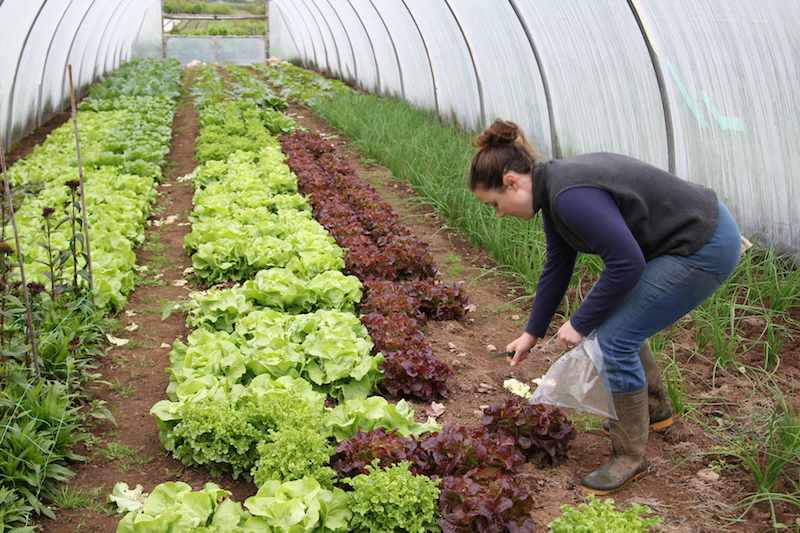
After planting the sprouts, we headed over the to the lettuce beds where we hoed weeds. Then, we walked over to the broccoli beds where we hoed some more. Although we use an oscillating hoe (i.e. it sits on a hinge and moves back and forth with our forward motion) it’s still hard on the back.
So, basically, farming is a lot of bending over and crouching, especially if a lot of the work is done by hand (which is it here). It’s work like this that makes us see why farmers use pesticides and herbacides. If they didn’t, they’d never be able to create as much crop as they do and a lot of it would be eaten by critters like slugs, birds and flies.
How does one advocate for organic when it’s so much work, more expensive, and at times seems unrealistic? I don’t have an answer, and I’m hoping by the end of our 5-month trip I’ll be a little closer. I see why farmers would choose not to be organic. Where do we meet in the middle? Do we decrease farms in size? They used to be smaller. Do we have people grow their own veg? I really don’t have an answer. Instead, I have more questions. But, if anything, our adventure is bringing the issues to life for me which is a good place to start.
Posted: May 10th, 2010 | Author: Halbe | Filed under: Wales | 1 Comment »
Generally, Britain is not unlike the U.S. but there are a couple of things that I’m noticing that are different. First, some of the names of vegetables are different here: they use the French name while we use the Italian. For example, they don’t say zucchini, but courgette and they call eggplants aubergines. The other difference we’re noticing in the homes we’ve stayed in is that they don’t use napkins nearly as much as we do in the states. We’ve eaten three meals with our new family in Wales and we haven’t seen a napkin in sight. I end up using my jeans instead. Good thing they’re already dirty and I don’t mind a bit more grit. They also put cream (whether clotted or double) on everything. Can’t complain too much about that though, cream makes everything better.
We’re at our new farm in Wales in a small town called Pencoed, pronounced “Pen-coid,” 15 miles from Cardiff. Today was our first day assisting them on their farm and we’ve already learned a bit about growing plants. Our schedule is not too different than our last farm except we’re done after lunch here and then have all day to putz around. We plan to take a few day trips and many walks in the area using their public footpaths, one of our favorite things about Britain so far.
Our day has us eating breakfast (porridge) with our hosts by 7:30 in the morning and out in the fields by 8:00 a.m. Today, we planted leeks into their fields (they have 23 acres and all plants are hand planted, weeded and maintained etc.). Then, we moved a number of french beans and squash into a cooler polytunnel (kind of like a greenhouse) to get them used to cooler weather. We’ll be planting those next week. As our host Yvonne says, “plants are like people, they don’t like to be too warm or too cold so you have to get them used to different temperatures gradually.”
By 1:30 we are eating lunch. Today we had homemade pizza, cous cous and amazing salad. The salad is the best part of the meals here since it’s literally cut from the garden and put into our bowls. Fresh salad greens make a huge difference. Devon and I plan to walk to the windmills tomorrow. You have to get creative with activities when you’re in a small town, that’s for sure. Windmills here we come!
Posted: May 6th, 2010 | Author: Halbe | Filed under: England | 3 Comments »
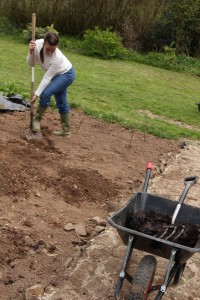
Halbe digging holes and filling them with manure (1 year old poo) to prepare for planting squash.
First, I covered poop with straw, then I shoveled poop and then I forked 1 year old poop into holes. Fun was definitely had. Most of this is part of our daily routine which has been handed over to me and Devon.
We wake up around 7 and are on the farm by 8 in our wellies to tend to the poultry (ducks, geese and chickens) and the pigs. We learned the holy trinity of farming – food, security and water (FSW which I remember by thinking of DSW – once a city girl always a city girl). So, we feed all of the animals, give them clean water, look for any eggs (I found two this morning!) and then make sure the electric fence is turned back on. Can’t let the animals get out or the foxes in.
By 8:30 we’re in the goat barn just as Ann, our charming host, is finishing up her milking. She only milks the six goats who had kids this season and uses it to make soft cheese, hard cheese and milk for drinking (I put it in my tea each morning). She actually showed Devon and me how to milk the other day. We both successfully milked, oh, about 1 tablespoon. It’s actually pretty tough to do.
As Ann is finishing with the goats, Devon and I work to clean up the pen and finish the morning routine. We fill the troughs with hay, fill their water buckets with clean water, and lastly deal with all of their poop, of which, there is a monumental amount. First, we get straw and work to cover all new poop and moist spots on the floor with new straw. Then, we wet the floor of the milking area (it’s concrete) and scrub it with the “wet broom” to get all the poop off the floor. Next, we let the goats out of their pen to wander about in the fields and begin to shovel the poop. You’d think that all goats do is poop (which wouldn’t be totally inaccurate) based on how much we end up shoveling.
After our morning routine is over Ann gives us our tasks for the day which have included hoeing in the garden, hand weeding, weed wacking or “strimming,” and weeding with a pitch fork. Yesterday I worked in the garden getting a bed ready for squash. The dirt here is rocky and dry so they use a lot of manure, which is created from the shoveling we do each morning.
My task was simple – dig a hole about 10 inches across and 8 inches deep. Next, I go to the enormous pile of manure, which is really just 1 year old goat poop, and fork enough of it into a wheel barrow. I wheel that over (trying not to tip it onto myself, which I almost did) and then fill the hole with manure. Then, I cover the manure with dirt and repeat 9 more times. I actually did this over two days and Devon helped with the last four. He’s a trooper.
We’re usually done with our work around 4 or 5 (sometimes 6 if it’s a long project) but have lots of food breaks in between. The schedule looks like this:
0800 – begin morning routine
0900 – come in for a proper breakfast (usually eggs and toast or cereal and yogurt)
1000 – continue with our work
1300 – eat lunch
1400 – finish up our projects
1600 – afternoon tea when the boys (aged 12 and 14) get home
1900 – dinner
Today I’m picking rocks out of seeded dirt so they don’t get caught in the mower and splitting wood. My muscles are growing as we speak.
Here are some other pictures of the farm and our work for those who are interested:
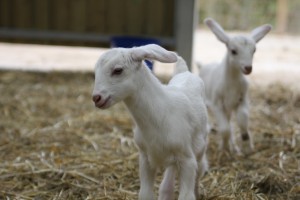
Two saanan kids
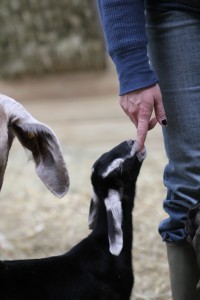
A billy kid (i.e. a male kid) suckling on Halbe's finger.

How we stay warm in the living room.
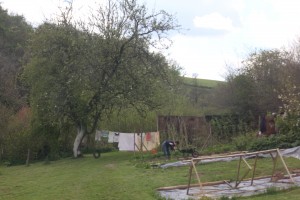
Halbe weeding - we did it for most of the day to prepare for squash
Posted: May 3rd, 2010 | Author: Halbe | Filed under: England | 13 Comments »
I’ve officially had the most embarrassing moment to date on our trip and, unfortunately, it involved an impressionable English boy. Whoops!
Devon and I had the day off yesterday and we had a wonderful 8 mile walk through mid Devon county. While on the walk, we passed many beautiful fields with sheep, cows and goats as we meandered through the narrow, winding streets lined with hedges almost as tall as I. As you walk along the streets, you come across fields with animal grazing but no public toilets.
Now, anyone who knows me know that I drink a lot of water and therefore, need to go to the bathroom with frequency. Being on an extended walk without restrooms (or toilets as they’re called here) presented a challenge. And, once I couldn’t take it any longer I pulled aside on a beautiful, quiet road into a nearby field thinking to myself, “who would possibly pass by out here in the middle of no where?”
Once I was in position a few seconds pass and as I’m finishing, a young boy looking to be about 8 passes me on his bicycle riding alongside with his dog. Before he knew it, his innocent Sunday ride turned into an educational tour of how a woman pees in the wild. As he passes me his eyes pop out of his head, his jaw drops and he stops pedaling. Luckily the momentum of his bike continued him on his way past the field. Once I see him, I yell, “oh, excuse me.” He continues on his way with the image of my bottom seared into his memory.
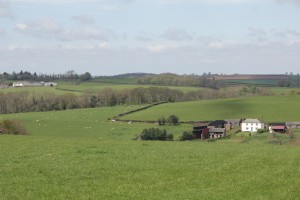
The field where it all happened
Devon and I make eye contact. He gives me this look of, “oh yes, that just happened.” I burst out laughing until I have tears in my eyes. The look on that little boys face was priceless. Can you imagine, you’re barely learning how to read and you come across a woman peeing in the field? Now THAT’S an education.
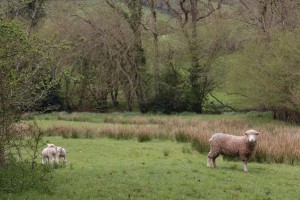
I was hoping these guys would be my only witness
I was mortified enough that I put on the sweater wrapped around my waist in the hopes that it’d mask my real identity should we pass the boy again. It was more for my comfort than anything though because how many people walk the streets of Devon? Sigh. I guess this does prove that Americans are less civilized than the British.
Posted: April 29th, 2010 | Author: Halbe | Filed under: London, Recipes | 9 Comments »
Devon and I made it to London, finally! We flew in on Monday afternoon and worked to keep our eyes open (man, it was rough) after having dinner with our family friend hosting us. We planned our day in London that evening and were off by 10 am the next day to have a full day exploring. We touched on quite a few biggies on that first day including, but not limited to:
Westminster Abbey
Houses of Parliament
London Bridge
Big Ben
Piccadilly Circus
Covent Garden
St. Paul’s Cathedral
Temple Bar
But, the meals, what about the meals (Fred, this is for you)? Well, our first meal in London was actually a dinner at an Italian restaurant which isn’t actually worth blogging about. But, my daily breakfast is – traditional porridge. Our host, Michael, makes porridge with raisins and milk every morning and it’s delicious. So, here’s what it is and how he makes it:
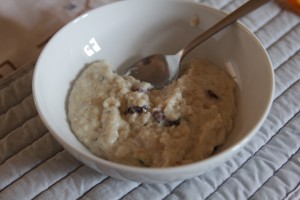
Ingredients: Oats (probably the minute kind), 2% or whole milk and raisins
How to make it:
Michael does something interesting, he allows the oats to soak in the milk for an hour or so before even cooking it (it makes the oats so soft) so that’s the first step. Soak the oats in milk in the pot for 30-60 minutes (ratio of oats to milk is 1:4). Next, add raisins and light a medium to high heat. Let the oats and milk cook for 15-20 minutes while stirring constantly, until thick and you’ve got porridge! So, delicious we don’t even use sugar. Now, that might be because the milk tastes different here but, it’s very, very tasty and not quite the same as oatmeal. It’s better!
After our breakfast with Michael, Devon and I usually have lunch in London and it’s not anything to write home about. In fact, our first lunch was at a traditional English pub. Devon ordered fish and chips, which he was were “pretty good” and I ordered a ham and mustard sandwich.
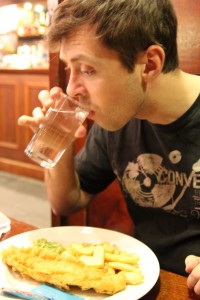 When I got the sandwich I was disappointed to discover that the British use butter instead of mayo. My sandwich had one slice of rubbery ham, butter on both sides and seedy mustard all between two unimpressive pieces of a nutty, whole wheat bread.
When I got the sandwich I was disappointed to discover that the British use butter instead of mayo. My sandwich had one slice of rubbery ham, butter on both sides and seedy mustard all between two unimpressive pieces of a nutty, whole wheat bread.
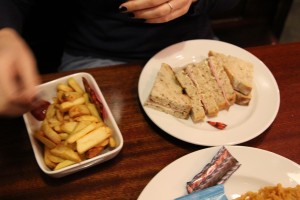
I only ate half of it – it wasn’t good, to say the least. My lunch was mostly the chips that came with it. So, I’ve discovered now why England isn’t known for it’s authentic food. But they are known for their Indian food and for a good reason. The only meal that’s even worth discussing was an Indian meal we had this evening in a town outside of London with our host. Indian food is the safest type in these parts. Go figure.
Next up: Goat cheese in Crediton. Yum!
Posted: April 18th, 2010 | Author: Halbe | Filed under: Los Angeles, Preparations, Unexpected Adventure | 2 Comments »
Since Devon and I are in L.A. for a few more days due to the volcanic ash powdering the entire continent of Europe, we’re making the most of it. We’re doing a stay-cation! So, in that vein, any must-do’s in Los Angeles before we leave? We’re open to suggestions. Some items on my list are:
1. Visit all the L.A. food trucks
2. Bike ride from Venice to Malibu and have breakfast on the beach (it’s been years since I’ve done this)
And…that’s where the list ends. My parents are in town through Tuesday and they’re from L.A. so new and exciting activities are always fun. Let the ideas and suggestions flow!




